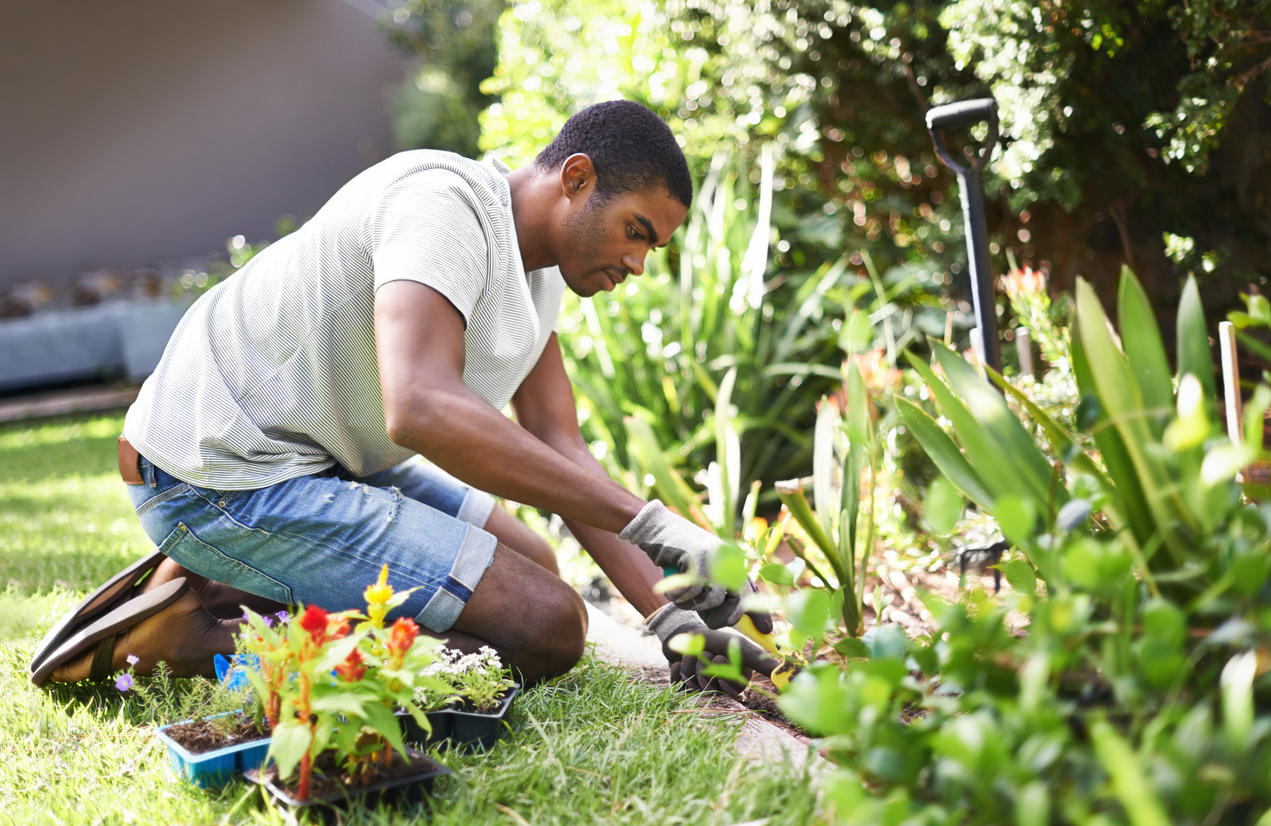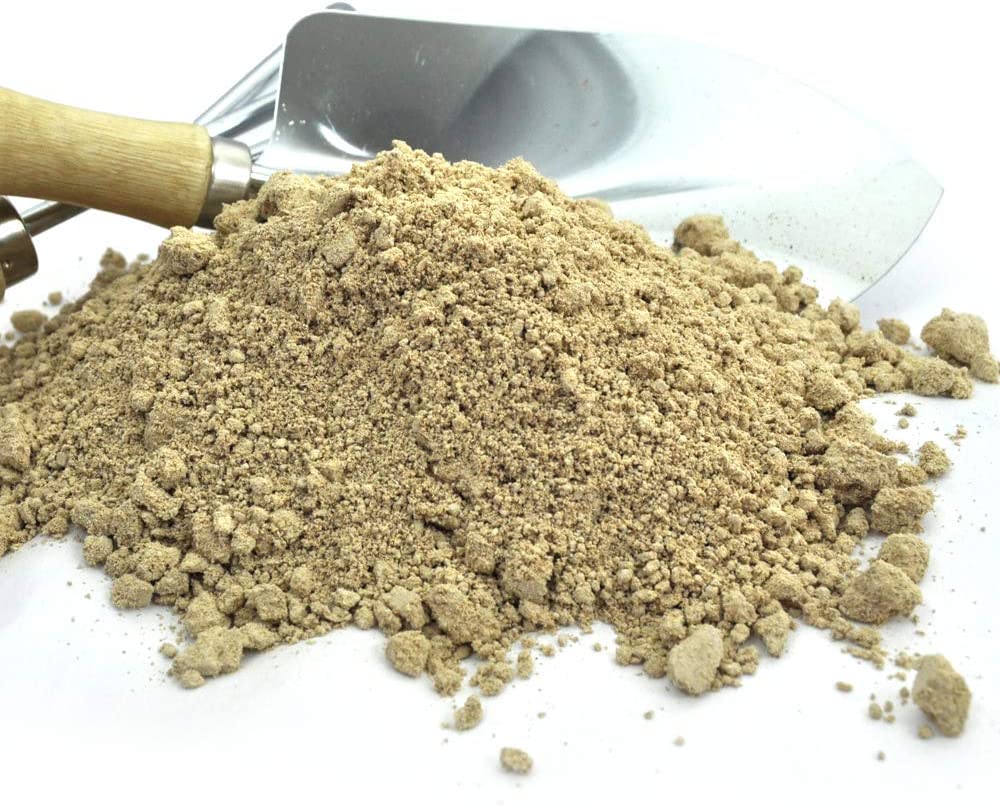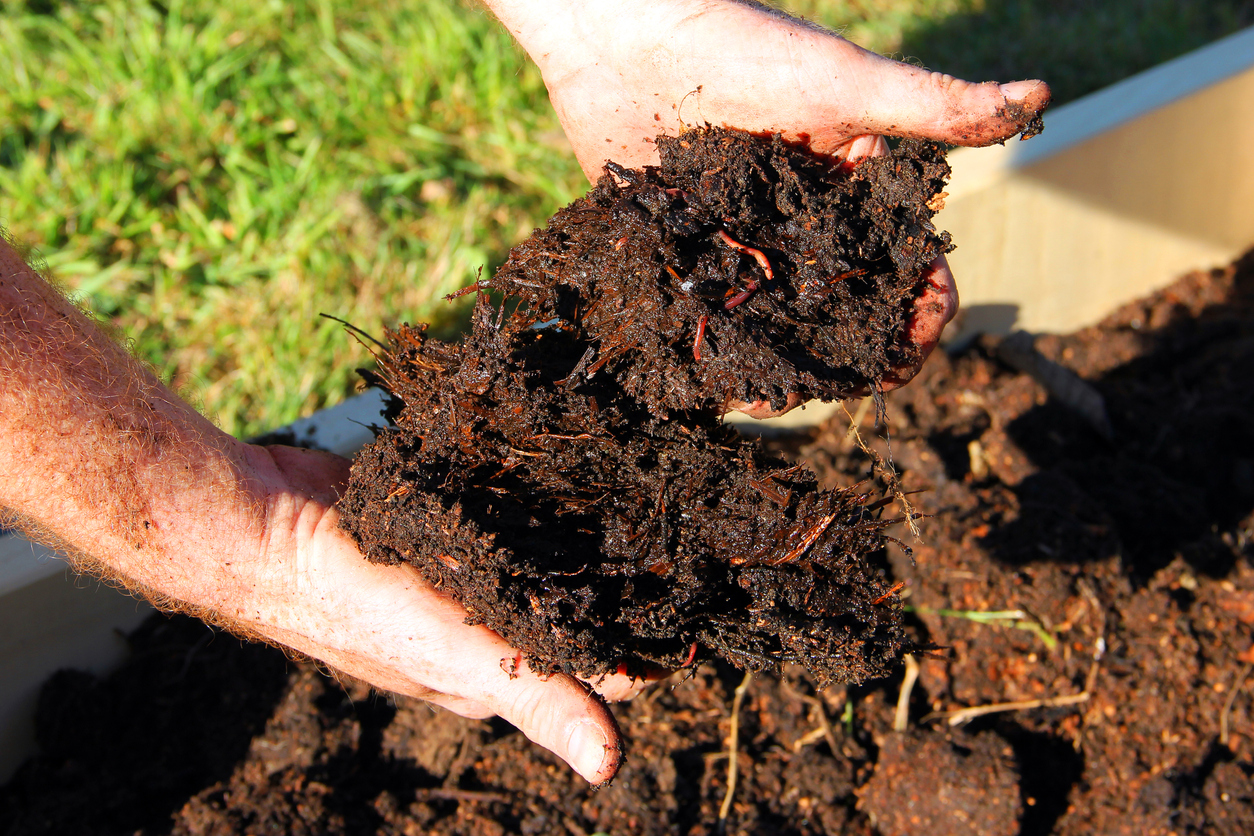

We may earn revenue from the products available on this page and participate in affiliate programs. Learn More ›
Maybe you’ve heard about soil amendments and have wondered what the term might mean for your garden. If you want to have lush flower beds or plenty of tomatoes and basil for caprese salad every night, the answer is yes, regardless of what soil type you have. Ahead, learn about why soil amendments are important, which amendments you should use, and how to improve your garden’s soil.
What Are Soil Amendments?
Any material that is mixed with soil to improve its physical or chemical properties is a soil amendment. This includes both organic and inorganic—mined or manmade—amendments. In most situations, organic amendments are best for the health of the soil.
If you live in a newer neighborhood, your soil likely consists of rocks, compacted clay, or other stuff the builders dug up or dropped in as they wrapped up construction. In older neighborhoods, where soil is more loamy, the soil might be simply “used up” or depleted of nutrients. Non-native plantings, erosion, introduced pathogens—all these can damage the health of soil, requiring some soil amending to bring it back to health. Vegetable gardens, certainly, need a healthy dose of compost every year to replenish the health of the soil.
RELATED: We Made More Than 100 Pounds of Natural Fertilizer to Find the 5 Best Compost Tumblers
Benefits of Soil Amendments

The specific benefits of soil amendments vary, of course, depending on what’s being added, but various amendments can:
- Add nutrients
- Improve drainage
- Help aeration
- Retain water
- Add needed microbes
- Fight diseases
Soil additions also can adjust pH levels and help change the natural soil composition to address the needs of non-native plants.
How to Choose the Right Soil Amendments
When deciding which soil amendments to add, organic compost is almost always an appropriate amendment to start with. Beyond that, your best bet is to use a soil test kit to identify any problem areas. A soil test kit will tell you what nutrients are needed and will help you understand how much to add.
It’s important to not throw the kitchen sink at your soil. Add compost, run a test to see where you are, and then layer in other amendments as needed.
Types of Soil Amendments
Gardeners looking to improve the quality and performance of their soil have many amendments from which to choose. These are the most common and effective:

1. Grass Clippings and Leaves
Use these two lawn waste items independently or together. For passive soil improvement, use a mower with a mulching deck to mow the lawn. A thin layer (about ½ inch) of mulched leaves or grass returns nutrients to the soil and helps to conserve water. Mulched leaves boost the soil’s carbon content and improve the ground for earthworms and other beneficial soil dwellers. Grass clippings decompose quickly, so you can add another thin layer later in the season.
To improve a garden bed for the next year, mix one part fresh grass clippings with two parts dry, shredded leaves in fall. Apply the mixture in a 6-inch layer on an empty garden bed to improve the soil over winter.
Good for: Vegetable and annual beds that gardeners cultivate each year for new seeds and transplants.
RELATED: What Is Leaf Mold and How to Use It in Your Home Landscape
2. Bone Meal

Bone meal is a traditional organic fertilizer that boosts a soil’s phosphorus level. It is available anywhere that gardening supplies are sold. Before adding bone meal and other fertilizers, it is best to perform a soil test to ensure that the soil needs this nutrient. Plants use phosphorus to grow roots, flowers, and fruit. Apply a bone meal such as Jobe’s Organics bone meal at the beginning of the growing season for season-long plant nourishment. Though instructions may vary by product, gardeners will generally sprinkle about 1 pound of powdered bone meal per 10 square feet of bed and then mix it into the top few inches of soil.
Good for: Seasonal fertilizing amendment for carrots, beets, or other root crops and for flowering plants like roses, tulips, and dahlias.
3. Biosolids
Biosolids are organic solids from wastewater treatment facilities.The material is stabilized by anaerobic digestion and composting to eliminate potentially dangerous pathogens, then packaged as commercial fertilizer. These fertilizers have been used in American agriculture, golf courses, and home gardening for more than a century. In addition to the added nutrients, this material boosts the levels of beneficial microbes and organic matter of the soil. Biosolids come as heat-dried products, composts, or Class A (federally approved) blends.
Home gardeners can find bagged biosolids at hardware stores or home and garden centers; some local utilities also offer them. Typically, 50 pounds of biosolids improve nitrogen in 400 to 600 square feet of growing space. Those sold for home gardening must meet stringent requirements to ensure they are safe to use. Use caution when buying biosolids; do your research to ensure they’re safe to use and not high in salt or metal content.
Good for: Gardeners who are serious about recycling and want to improve soil organic matter and physical properties of the soil.
4. Wood Ash

If you burn firewood in a wood stove or fireplace, the garden is a good place to dispose of the ash. Wood ash can replace lime to raise the soil pH. It also boosts the levels of potassium and many of the trace elements that plants need.
With wood ash, a little goes a long way. You can harm soil if you add too much at once. Scatter wood ash fertilizer over the garden at a rate of about 20 pounds (5 gallons) per 1,000 square feet. Or, sprinkle some on the compost pile every time you add new waste.
Good for: Raising pH in acidic soil to grow plants that need neutral or slightly alkaline pH conditions.
RELATED: 15 Secret Ingredients to Make Your Garden Grow
5. Compost

Whether you make your own or buy it from a store, compost is one of the most familiar and beneficial soil amendments. Companies and home gardeners make compost from virtually any organic material, from weeds and veggie scraps to cardboard and sewage sludge. Consequently, quality, texture, and nutrient loads vary significantly. Mushroom compost is a byproduct from commercial mushroom production; it will break down quickly in the soil and help with soil retention.
Mix compost into the soil before planting, adding 3 to 4 inches of compost to new garden beds and an inch or less to existing beds each year. Add compost as mulch on the soil surface after planting, or brew it into compost tea for foliar feeding.
Good for: Improving soil health and structure, preventing soil erosion, conserving water, and reducing waste.
RELATED: The Best Things You Can Do for Your Garden Soil
6. Paper and Cardboard
Online shopping has become so popular that it’s great to know there is a way to use some of that packing material in the garden. Paper and cardboard can function as biodegradable weed barriers in empty beds by simply layering the material on the garden bed and covering it with 4 to 6 inches of wood chips or other organic materials. Use large pieces and overlap them by a few inches. Avoid placing these layers on active garden beds, because the layers can limit air and water flow into the soil. You also can shred paper or cardboard to add to the compost pile as a carbon source.
Good for: Sheet mulching in the off-season to smother weeds and eventually decompose in soil to compost in place.
7. Perlite

Small lumps of white that look a bit like Styrofoam, perlite is made from volcanic glass that expands and becomes porous when it’s heated to about 1,600 degrees Fahrenheit. These permeable bits increase the amount of oxygen held in the soil, and greatly improves aeration. Perlite also improves drainage while retaining water and nutrients that are gradually released back into the soil to irrigate plants. If you’re gardening in containers, mixing two-thirds potting soil and one-third perlite will yield a hearty potting mix.
Good for: Perlite added to soil used in container gardening can prevent compaction and improve soil’s water retention.
8. Composted Manure
Composted manure is animal waste that has been allowed to decompose. When mixed into a garden bed, it supplies nitrogen, phosphorus, potassium as well as micronutrients that plants need. It also provides a boost of organic matter to the soil. Commercially available composted manure can be made solely from manure, but often contains other composted materials such as straw or sawdust.
Spread a 2- to 3-inch layer of composted manure over your garden bed and then mix it into the soil several inches deep. Typically, composted manure has been processed to the point where it’s nearly odorless, but there may be a slightly unpleasant odor associated with this amendment. Never add fresh manure to a garden.
Good for: Composted manure can supply lots of nitrogen and other nutrients plants need when mixed into soil.
RELATED: 7 Things to Know About Hugelkultur Gardening
9. Wood Chips

Wood chips come from tree trunks, limbs, and branches about 12 inches in diameter and smaller. They should be allowed to age before using them in the garden. As the material sits for at least 6 months, beneficial organisms colonize it and begin the slow process of turning it into soil. Earthworms can thrive in gardens with wood chips. Using those sourced locally is a sustainable approach.
Technically, the chips work as mulch, sitting on the soil surface to help keep plant soil from drying out too quickly and even cool roots. The wood eventually composts in place and can trickle down to amend soil over time (about 10 years). Apply wood chips in a 2- to 4-inch layer around established plants. You often can get a free truckload of wood chips delivered from most tree-pruning and removal companies.
Good for: A mulch to cover and protect soil and roots, breaking down to amend soil in the long term, and for an excellent earthworm environment.
10. Lime
Made from ground limestone rock, lime is used to make soil pH less acidic and more alkaline, which is desirable for plants such as columbine, salvia, and lavender. If your soil is naturally acidic, but you want to grow these plants, consider mixing lime in. Garden lime is also high in calcium, an essential nutrient for plant growth. Before you begin, however, you should use a pH testing device to measure your soil’s alkalinity and dose appropriately.
Good for: Lime is a good soil amendment to reduce the acidity of soil.
11. Vermiculite

Vermiculite is a mineral that also expands when heated. As a soil amendment, it is very effective at retaining water, even holding too much for some plants, which can lead to root rot. But for plants that like their feet wet, vermiculite is a good addition. Small granules of vermiculite are often used for seed germination.
To create a growing medium that’s appropriate for thirsty plants, mix one-third to one-half vermiculite with good-quality potting soil.
Good for: Vermiculite is best used in containers growing water-loving plants such as ferns, spider plants, and lucky bamboo. It’s also good for rooting cuttings.
RELATED: Vermiculite vs. Perlite: Which is Best for Your Potted Plants?
12. Gypsum
You may have heard about gypsum as a soil amendment, but this mineral is typically used in commercial farming only. Gypsum’s use as a soil amendment for home gardeners is limited to two types of soil. Salty soil in coastal areas might benefit from gypsum’s ability to remove sodium from the soil and replace it with calcium. And gypsum applied to areas where the soil has a high clay content will benefit from gypsum’s ability to change the structure and fertility of heavy clay soils, and so is a good way of amending clay soil.
Good for: Gypsum is a good soil additive for areas that have salty soil, such as arid and coastal regions, and places where heavy clay soils are common, such as the southeastern United States.
RELATED: Know the Types of Soil
13. Diatomaceous Earth

Typically, diatomaceous earth is thought of as a pest management tool. The sharp bits of this substance, which is composed of fossilized aquatic organisms, do lethal damage to the innards of certain bugs when the powder is inhaled. But diatomaceous earth can be used as a soil additive, too, where it could enhance nutrient retention and moisture retention in soil. It contains silica, which helps to make plants more tolerant of drought and heat.
Dust a thin layer on your beds and then mix into the soil thoroughly so it won’t impact beneficial insects visiting your garden. It doesn’t harm earthworms.
Good for: Diatomaceous earth improves soil water retention and drought tolerance.
14. Sphagnum moss

If you wish to increase the acidity of your soil, to grow azaleas, rhododendrons, or blueberries, for example, consider mixing in sphagnum moss, which is sold dried and is sometimes used in crafting. The stringy, fibrous product sold in garden centers might help lower your soil’s pH; it can also improve drainage. Apply a 4-inch layer of sphagnum moss to your bed and thoroughly mix it into the top 6 to 8 inches of soil. You’ll have to repeat this amendment every couple years.
Good for: Helping to lower soil pH for acid-loving plants and to improve drainage.
FAQs
Fertilizers provide a direct supply of nutrients to plant roots, typically for a short period of time, whereas soil amendments improve the physical condition and balance of the soil.
You should understand the deficiencies that exist in your soil in order to know which amendment to choose. Understand your soil’s needs by performing a soil test.
Final Thoughts
Building your dirt to its maximum potential is an ongoing process that should start with a soil test that measures nutrients and pH, which will give you an idea of the amendments needed. As you build your healthy soil, you will marvel at the beautiful plants and bountiful harvest your newly improved soil can produce.
